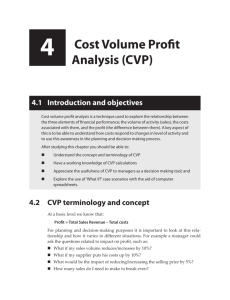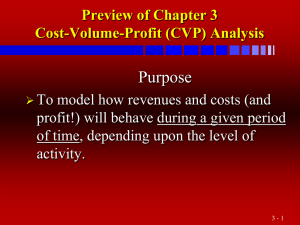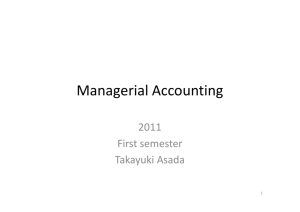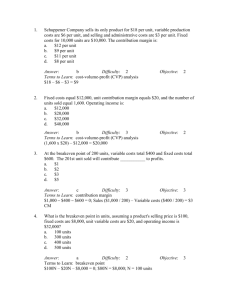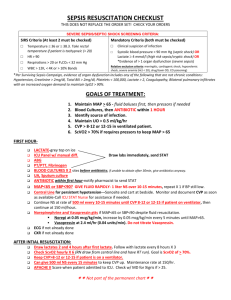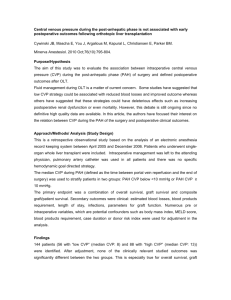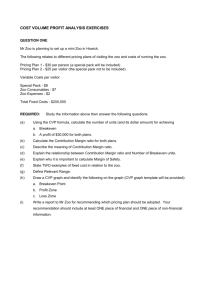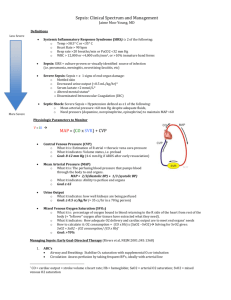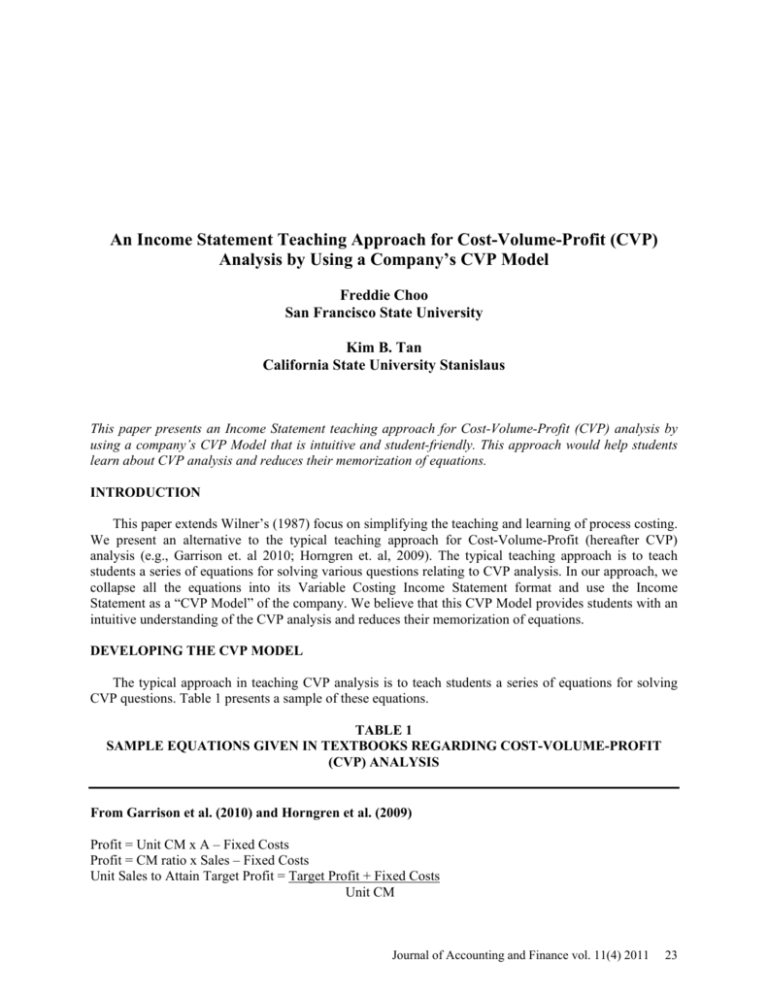
An Income Statement Teaching Approach for Cost-Volume-Profit (CVP)
Analysis by Using a Company’s CVP Model
Freddie Choo
San Francisco State University
Kim B. Tan
California State University Stanislaus
This paper presents an Income Statement teaching approach for Cost-Volume-Profit (CVP) analysis by
using a company’s CVP Model that is intuitive and student-friendly. This approach would help students
learn about CVP analysis and reduces their memorization of equations.
INTRODUCTION
This paper extends Wilner’s (1987) focus on simplifying the teaching and learning of process costing.
We present an alternative to the typical teaching approach for Cost-Volume-Profit (hereafter CVP)
analysis (e.g., Garrison et. al 2010; Horngren et. al, 2009). The typical teaching approach is to teach
students a series of equations for solving various questions relating to CVP analysis. In our approach, we
collapse all the equations into its Variable Costing Income Statement format and use the Income
Statement as a “CVP Model” of the company. We believe that this CVP Model provides students with an
intuitive understanding of the CVP analysis and reduces their memorization of equations.
DEVELOPING THE CVP MODEL
The typical approach in teaching CVP analysis is to teach students a series of equations for solving
CVP questions. Table 1 presents a sample of these equations.
TABLE 1
SAMPLE EQUATIONS GIVEN IN TEXTBOOKS REGARDING COST-VOLUME-PROFIT
(CVP) ANALYSIS
From Garrison et al. (2010) and Horngren et al. (2009)
Profit = Unit CM x A – Fixed Costs
Profit = CM ratio x Sales – Fixed Costs
Unit Sales to Attain Target Profit = Target Profit + Fixed Costs
Unit CM
Journal of Accounting and Finance vol. 11(4) 2011
23
Dollar Sales to Attain Target Profit = Target Profit + Fixed Costs
CM Ratio
Unit Sales to Breakeven = Fixed Costs
Unit CM
Dollar Sales to Breakeven = Fixed Costs
CM Ratio
(Unit Selling Price x A) – (Unit Variable Cost x A) – Fixed Costs = Income
Target Income = Target Net Income
1 – Tax Rate
Unit Sales = Fixed Costs + Target Income
1 – Tax Rate
Unit CM
Note: A = Unit Sales, CM = Contribution Margin, CM Ratio = CM% = CM ÷ Sales
In our Income Statement approach, we use the Variable Costing Income Statement to perform CVP
analysis. The Variable Costing Income Statement is shown horizontally as:
Sales – Variable Costs – Fixed Costs = Income
which also can be written vertically as:
Sales
- Variable Costs
Contribution Margin
- Fixed Costs
Income
Each of the above Sales and Variable Costs is an equation:
Left-side-view
Sales
- Variable Costs
Contribution Margin
- Fixed Costs
Income
Right-side-view
Unit Selling Price
Unit Variable Cost
x No. of Units
x No. of Units
When we complete the rest of the Income Statement, we get:
Left-side-view
Sales
- Variable Costs
Contribution Margin
- Fixed Costs
Income
Right-side-view
Unit Selling Price
Unit Variable Cost
(Unit Selling Price – Unit Variable Cost)
Fixed Costs
Income
x No. of Units
x No. of Units
x No. of Units
The left-side-view shows the macro-view of a company. The right-side-view shows the micro-view of a
company, and it shows the parameters of the company that can be varied or kept constant in a CVP
analysis.
In order to know which parameters can be varied or kept constant, some Cost Behavior knowledge is
required. Therefore, CVP analysis is best taught after students have learnt the topic of Cost Behavior that
Fixed Costs and Unit Variable Cost remain constant unless there is information provided to change them.
24
Journal of Accounting and Finance vol. 11(4) 2011
In CVP analysis, the Unit Selling Price also is assumed to be constant. Thus, at the right-side-view of the
Income Statement, there are three constant parameters and these are shown in bold below:
Left-side-view
Sales
- Variable Costs
Contribution Margin
- Fixed Costs
Income
Right-side-view
Unit Selling Price
Unit Variable Cost
(Unit Selling Price – Unit Variable Cost)
Fixed Costs
Income
x No. of Units
x No. of Units
x No. of Units
Both the left- and right-side-views (as shown above and in Panel A of the Appendix) make up a “CVP
Model” of a company. When students examine the right-side-view of the CVP Model, they see that there
are 3 constant parameters (Unit Selling Price, Unit Variable Cost, and Total Fixed Costs) and that there
are two unknowns, Number of Units and Income, and they realize the term C-V-P relates to how the three
factors of Costs, Volume (No. of Units), and P (Income) are related to a company.
As the data given for companies can vary, we will limit our discussion in this paper to the following
six company situations:
1. Number of units is of interest, and there is no tax given.
Assume Jehan Company sells a single product. The unit selling price is $70, the unit variable cost is $42,
and total fixed costs are $84,000.
2. Number of units is of interest, and tax rate is given.
Assume Jehan Company sells a single product and has a tax rate of 30%. The unit selling price is $70,
the unit variable cost is $42, and total fixed costs are $84,000.
3. Number of units is not of interest, and there is no tax given.
Assume Ezen Company has revenue of $80,000, variable costs $20,000 and fixed costs $40,000.
4. Number of units is not of interest, and tax rate is given.
Assume Ezen Company has revenue of $80,000, variable costs $20,000 and fixed costs $40,000. It also
has a tax rate of 20%.
5. Company has multiple products, sales mix is available, and there is no tax given.
Assume West Company makes three products, P1, P2, and P3. The sales of P1, P2, and P3 are 2000,
3000, and 5000 units respectively.
6. Company has multiple products and tax, and sales mix information is available.
Assume West Company makes three products, P1, P2, and P3. The sales of P1, P2, and P3 are 2000,
3000, and 5000 units respectively. The tax rate is 25%.
We start with the first situation.
Situation 1: Number of units is of interest, and there is no tax given.
Assume Jehan Company sells a single product. The unit selling price is $70, the unit variable cost is
$42, and total fixed costs are $84,000.
We first set up Jehan Company’s CVP Model before we do CVP analysis. Based on the knowledge of
Cost Behavior, the above data given pertains to the constant parameters that go into the right-side-view of
the CVP Model is as follows:
Journal of Accounting and Finance vol. 11(4) 2011
25
Left-side-view
Sales
- Variable Costs
Contribution Margin
- Fixed Costs
Income
Right-side-view
70X
42X
28X
84000
Income
(where X = number of units)
28X – 84000 = Income
The right-side-view of the company’s CVP Model has two unknowns, X and Income. Note that most
of the CVP analysis can be done using the bottom three rows of the income statement, 28X – 84000 =
Income, and the analysis revolves around asking students to solve for X or Income. Next we use the CVP
Model to answer some questions related to CVP analysis.
Q: What is the breakeven point in units?
We use the bottom three rows from the right-side-view of the CVP Model, 28X – 84000 = Income.
Breakeven means that the bottom-line of the Income Statement is zero. Thus, let Income = 01, and solve
for X. 28X – 84000 = 0, and solving X = 3000.
Q: What is the breakeven point in sales dollars?
Since the first row of the CVP Model is Sales = 70X, Sales = 70(3000) = $210,000.
Q: How to draw the CVP graph?
The CVP graph has two straight lines, Sales and Total Costs. To draw the CVP graph, we need the
equations of these 2 lines. From the first row of the CVP Model, Sales = 70X. Since Total Costs =
Variable Costs + Fixed Costs, we use the second and fourth rows of the CVP Model to get Total Costs =
42X + 84000. The CVP graph is presented as:
FIGURE 1
COST-VOLUME-PROFIT (CVP) GRAPH
Sales = 70X
$
Total Costs = 42X + 84,000
$84,000
3,000
No. of units (X)
Breakeven Point (in units)
From the CVP Graph, we can see that the company needs to sell more (less) than the breakeven point in
order to make a profit (loss). A measure of how successful a company is the extent to which its sales
exceed its breakeven point.
26
Journal of Accounting and Finance vol. 11(4) 2011
Q: How to draw the Income graph?
From the bottom three rows of the CVP Model, Income = 28X – 84000. Thus the Income graph is
presented as:
FIGURE 2
INCOME GRAPH
Income
Income = 28X – 84,000
0
No. of units (X)
Breakeven Point
-$84,000
Q: How many units must the company sell to make an income of $4,000?
From the bottom three rows of the CVP Model, 28X – 84000 = Income, we let Income = 4000, and
solve for X. 28X – 84000 = 4000, X = 3143(rounding).
Q: What is income if the company sells 2500, 4500, or 5000 units?
Let X = 2500, 4500, and 5000 as follows:
Number of units (X)
Sales
- Variable Costs
Contribution Margin
- Fixed Costs
Income
X
70X
42X
28X
84000
Income
2500
70(2500)
42(2500)
28(2500)
84000
Income
4500
70(4500)
42(4500)
28(4500)
84000
Income
5000
70(5000)
42(5000)
28(5000)
84000
Income
From the income statements above, we can see clearly how costs behave, that is, Fixed Costs and Unit
Variable Cost remain constant. Furthermore, the Unit Selling Price also remains constant. We solve for
Income as follows:
Number of units
Sales
- Variable Costs
Contribution Margin
- Fixed Costs
Income
X
70X
42X
28X
84000
Income
2500
175000
105000
70000
84000
-14000
4500
315000
189000
126000
84000
42000
5000
350000
210000
140000
84000
56000
Journal of Accounting and Finance vol. 11(4) 2011
27
Q: What is the company’s breakeven point if the unit selling price increases by 10%, fixed costs decrease
by 5%, and unit variable cost increases by 15%? How many units must the company sell to get a target
income of $5,000?
Here, we need to update the CVP Model as its parameters (that is, unit selling price, unit variable cost
and total fixed costs) which are usually assumed to be constant are changed. The CVP Model is updated
as follows:
Sales
- Variable Costs
Contribution Margin
- Fixed Costs
Income
70(1.10)X
42(1.15)X
?X
84000(0.95)
Income
Unit Selling Price is increased by 10%
Unit Variable Cost is increased by 15%
Unit Contribution Margin has to be updated
Fixed Costs are decreased by 5%
The CVP Model now has a new set of constant parameters:
Sales
- Variable Costs
Contribution Margin
- Fixed Costs
Income
77 X
48.3X
28.7X
79800
Income
28.7X – 79800 = Income
Instead of using the whole Income Statement, again we can use its bottom three rows, 28.7X – 79800 =
Income, to perform the CVP analysis as this shorter equation is sufficient and easy to solve. To find the
breakeven point, we let the bottom-line be zero, that is, let Income = 0, and solve for X. Thus, 28.7X –
79800 = 0, and X = 2781 (rounding).
Next, to answer how many units the company must sell to get a target income of $5,000, we let
Income = 5000. Again, we use the bottom three rows of the CVP Model,
28.7X – 79800 = 5000, thus X = 2955 (rounding).
Situation 2: Number of units is of interest, and tax rate is given.
Assume Jehan Company sells a single product and has a tax rate of 30%. The unit selling price is $70,
the unit variable cost is $42, and total fixed costs are $84,000.
To incorporate tax, a “CVP Model With Tax” is set up. This is shown in Panel B of the Appendix.
This Model also has two unknowns, X and NIBT (that is, Net Income Before Tax instead of Income). In
CVP analysis, the tax rate is assumed to be constant. Since this Variable Costing Income Statement is
longer than the one shown in Panel A of the Appendix, we perform most CVP analysis using two steps
labeled (a) and (b) below; the first step is to use equation (a) and the second step is to use equation (b).
Left-side-view
Sales
- Variable Costs
Contribution Margin
- Fixed Costs
NIBT
- Tax
NIAT
Right-side-view
70X
42X
28X
84000
NIBT
0.3NIBT
0.7NIBT
28X – 84000 = NIBT …...(b)
Note: Tax is calculated based on NIBT
…………………….………… (a)
When the company needs to find its breakeven point or how many units to achieve a target income,
step (a) is performed first whereby we let the bottom-line 0.7NIBT = 0 or 0.7NIBT = Target Income, and
we solve for NIBT. Next, we put the NIBT that we found from step (a) into the equation for (b), and solve
for X.
28
Journal of Accounting and Finance vol. 11(4) 2011
Q: What is the breakeven point in units? In sales dollars?
Breakeven is when the bottom-line is zero. Thus, we use equation (a) by letting 0.7NIBT = 0.
Solving, we get NIBT = 0.
Next, we use equation (b). From (a), we found NIBT = 0 which we substitute into 28X – 84000 =
NIBT and solve for X. Thus, 28X – 84000 = 0, X = 3000 units. To find breakeven in sales dollars, we use
the first row of the income statement, Sales = 70X = 70(3000) = $210,000.
Q: If the company’s income tax is 30%, how many units must the company sell to earn a target income
(or income after tax) of $2,000?
Using the CVP Model with Tax from Panel B of the Appendix, we start with equation (a). The target
income is $2000, so we let the bottom-line 0.7NIBT = 2000, and get NIBT = 2857.14. Next, we use
equation (b) from the CVP Model; we put what we found from (a) into (b), and solve for X. Thus, 28X –
84000 = 2857.14, and X = 3103(rounding). Thus, the company needs to sell 3103 units to get an income
after tax of $2,000.
Situation 3: Number of units is not of interest, and there is no tax given.
Assume Ezen Company has revenue of $80,000, variable costs $20,000 and fixed costs $40,000.
In some companies, there is no information regarding “Number of Units.” Thus, we cannot use the
CVP Models in Panels A and B of the Appendix. We can use a CVP “Percentage” Model that is shown in
Panel C of the Appendix and as shown below:
Left-side-view
Sales
- Variable Costs
Contribution Margin
- Fixed Costs
Income
Right-side-view
Sales%
Variable Costs%
Contribution Margin%
Fixed Costs
Income
x Sales
x Sales
x Sales
Like the CVP Models in Panels A and B, the CVP Percentage Model in Panel C also has three constant
parameters (shown in bold above). The percentages (of Sales) are calculated as follows:
Sales%
Variable Costs%
Contribution Margin%
= Sales / Sales
= Variable Costs / Sales
= Sales% - Variable Costs% = Contribution Margin / Sales
This CVP Percentage Model also has 2 unknowns. These are S (that is, Sales) and Income. In most CVP
analysis questions, we let one of the unknowns take on a value, and solve the remaining unknown.
For Ezen Company, the percentages come to:
Sales%
Variable Costs%
Contribution Margin%
= Contribution Margin / Sales
= 0.75
= 80000 / 80000
= 20000 / 80000
= Sales% - Variable Costs%
= 100% or 1.00
= 25% or 0.25
The CVP Percentage Model for Ezen Company is:
Journal of Accounting and Finance vol. 11(4) 2011
29
Sales
- Variable Costs
Contribution Margin
- Fixed Costs
Income
1.00S
0.25S
0.75S
40000
Income
(where S = Sales)
0.75S – 40000 = Income
We use just the bottom three rows of the Model, 0.75S – 40000 = Income, to solve the CVP questions
below.
Q: What is the breakeven point for Ezen Company?
Breakeven is when the bottom-line is zero. Let Income = 0, and solve for S. Thus, 0.75S – 40000 = 0,
S = $53,334.
Q: What do the CVP and Income graphs look like?
The CVP graph has two lines, Sales and Total Costs. Their equations from the CVP Percentage
Model are Sales = 1.00S and Total Costs = Variable Costs + Fixed Costs = 0.25S + 40000.
FIGURE 3
COST-VOLUME-PROFIT (CVP) GRAPH
Sales = 1.00S
$
Total Costs = 0.25S + 40,000
$40,000
Sales (S)
Breakeven Point (in sales dollars)
The Income graph has 1 line, the Income line. Again, from the CVP Percentage Model for Ezen
Company, Income = 0.75S – 40000.
30
Journal of Accounting and Finance vol. 11(4) 2011
FIGURE 4
INCOME GRAPH
Income
Income = 0.75S – 40,000
0
Sales (S)
Breakeven Point
-$40,000
Q: How much sales must the company make to generate an income of $12,000?
The CVP Percentage Model has two unknowns, S and Income. To answer this question, we let
Income = 12000, and solve for S. Thus, 0.75S – 40000 = 12000, and S = $69,334 (rounding).
Q: What is income if sales are $20000, $25000, or $80000?
Using the bottom three rows of the Model, 0.75S – 40000 = Income, we let S = $20000, $25000, and
$80000, and solve for Income.
Sales (S)
Sales
- Variable Costs
Contribution Margin
- Fixed Costs
Income
S
20000
25000
80000
1.00S 1.00(20000) 1.00(25000) 1.00(80000)
0.25S 0.25(20000) 0.25(25000) 0.25(80000)
0.75S 0.75(20000) 0.75(25000) 0.75(80000)
40000
40000
40000
40000
Income
-25000
-21250
20000
Q: Assume the current sales are $100,000. The company is considering a proposal to spend $8,000 on
advertising to increase its sales by 5%? Is the proposal a good idea?
The current CVP Percentage Model for Ezen Company is:
Sales
- Variable Costs
Contribution Margin
- Fixed Costs
Income
1.00S
0.25S
0.75S
40000
Income
(where S = Sales)
0.75S – 40000 = Income
When S = 100000, Income = 0.75(100000) – 40000 = 35000.
The proposed CVP Percentage Model is:
Journal of Accounting and Finance vol. 11(4) 2011
31
Sales
- Variable Costs
Contribution Margin
- Fixed Costs
Income
1.00S(1.05)
0.25S(1.05)
0.75S(1.05)
40000 + 8000
Income
(where S = Sales)
0.75S(1.05) – 48000 = Income
At S = 100000, the proposed Model shows Income = 0.75(100000)1.05 – 48000 = 30750. Since the
proposal will bring in a lower income of $4,250 (or 35000 - $30750), the proposal is not a good idea.
Situation 4: Number of units is not of interest, and tax rate is given.
Assume Ezen Company has revenue of $80,000, variable costs $20,000 and fixed costs $40,000. It also
has a tax rate of 20%.
The CVP Percentage Model With Tax, as shown in Panel D of the Appendix, is set up for Ezen
Company such that it has only two unknowns, S and NIBT:
Left-side-view
Sales
- Variable Costs
Contribution Margin
- Fixed Costs
NIBT
- Tax
NIAT
Right-side-view
1.00S
0.25S
0.75S
40000
NIBT
0.2NIBT
0.8NIBT
(where S = Sales)
0.75S – 40000 = NIBT
(b)
(a)
The tax rate is assumed to be constant. As the Income Statement with Tax is longer, we can use two short
equations, starting with (a) and followed by (b).
Q: What is the breakeven point?
Since breakeven is when the bottom-line is zero, we use equation (a), and let 0.8NIBT = 0. Solving,
we get NIBT = 0. The next step is to put NIBT = 0 into equation (b). Thus 0.75S – 40000 = 0, and
solving, we get S = $53334(rounding).
Q: How much sales to get a target income (that is, income after tax) of $2,000?
We use the CVP Percentage Model with Tax as shown in Panel D of the Appendix. We start with (a).
Since the bottom-line is $2,000, we let 0.8NIBT = 2000, and we get NIBT = 2500. Next, we put NIBT =
2500 into (b). Thus, 0.75S – 40000 = 2500, and we get S = $56,667.
Situation 5: Company has multiple products, sales mix is available. and there is no tax given.
Assume West Company makes three products, P1, P2, and P3. The sales of P1, P2, and P3 are 2000,
3000, and 5000 units respectively. Further information includes:
P1
P2
P3
Unit selling price
$ 10
$6
$4
Unit variable cost
2
2
2
Unit contribution margin
8
4
2
The total fixed costs for West Company are $15,000.
Preliminary work is needed before we can set up a CVP Model for a company with multiple products.
The preliminary work is to (i) determine the sales mix for the company and (ii) use this sales mix to
determine a “weighted contribution margin” that is used as a constant parameter in the CVP model.
(i) Sales Mix
The total sales for the company are 2000 + 3000 + 5000 = 10000. The sales mix for P1 is 2000/10000 =
0.2, P2 is 3000/10000 = 0.3, and P3 is 5000/10000 = 0.5.
32
Journal of Accounting and Finance vol. 11(4) 2011
(ii) Weighted Contribution Margin
We weight the first three rows by the sales mix:
P1
Weighted Unit Selling Price
10(0.2)
Weighted Unit Variable Cost
2(0.2)
Weighted Contribution Margin
8(0.2)
= 1.6
to get:
P1
Sales
2T
Variable Costs
0.4T
Contribution Margin
1.6T
P2
6(0.3)
2(0.3)
4(0.3)
= 1.2
P3
4(0.50)
2(0.50)
2(0.50)
=1
West
5.8
2.0
P2
1.8T
0.6T
1.2T
P3
2.0T
1.0T
1.0T
West
5.8T
2.0T
3.8T
3.8
where T = Total Company Sale Units. The West Company’s CVP Model with Multiple Products is:
Sales
- Variable Costs
Contribution Margin
- Fixed Costs
Income
5.8T
2.0T
3.8T
15000
Income
(where T = Total Company Sale Units)
3.8T – 15000 = Income
The CVP Model for Multiple Products is similar to the earlier CVP Models (see Panels A to D of the
Appendix) that we discussed. The CVP Model for Multiple Products also has two unknowns, T (No. of
Company’s Sales in Units) and Income.
Q: What is the breakeven point?
Breakeven is when the bottom-line is zero, 3.8T – 15000 = 0. Solving, we get T = 3948 (rounding).
To get the individual product sales, we use the sales mix; breakeven sales for P1 is 0.2(3948), P2 is
0.3(3948), and P3 is 0.5(3948).
Q: How many units of P1, P2, and P3 must the company sell to make an Income of $60,000?
To answer this question, we use the CVP Model which was set up above for West Company. Let
Income = 60000, so 3.8T – 15000 = 60000. Solving, T = 19737. Using the sales mix information, sales of
P1, P2, and P3 should be 0.2(19737), 0.3(19737), and 0.5(19737) respectively.
Situation 6: Company has multiple products and tax, and sales mix information is available.
Assume we use the same West Company as given in example 5, but includes a tax rate of 25%.
We set up a CVP Model With Tax similar to what was set up in Panels B and D of the Appendix. For
this example 6, the CVP Model has two unknowns, NIBT and T, where T = total company sales.
Left-side-view
Right-side-view
Sales
5.8T
(where T = Total Company Sale Units)
- Variable Costs
2.0T
Contribution Margin
3.8T
- Fixed Costs
15000
3.8T - 15000 = NIBT …...... (b)
NIBT
NIBT
- Tax
0.25NIBT
NIAT
0.75NIBT
………..…………………….. (a)
/
We use two steps, (a) and (b), to answer most CVP questions.
Journal of Accounting and Finance vol. 11(4) 2011
33
Q: What is the breakeven point?
Since breakeven is when the bottom-line is zero, we use equation (a) to get 0.75NIBT = 0, and
solving we get NIBT = 0. The next step is to put NIBT = 0 into equation (b). Thus 3.8T – 15000 = 0, and
solving we get T = 3948(rounding). The breakeven sales of P1, P2, and P3 should be 0.2(3948),
0.3(3948), and 0.5(3948) respectively.
Q: How much sales to get a target income (that is, income after tax) of $60,000?
We use the CVP Percentage Model with Tax as shown in Panel F of the Appendix. We start with (a).
Since the bottom-line is $60,000, we let 0.75NIBT = 60000, and we get NIBT = 80000. Next, we put
NIBT = 80000 into (b) to get 3.8T – 15000 = 80000. Solving, we get T = 25000. Furthermore, the sales of
P1, P2, and P3 should be 0.2(25000), 0.3(25000), and 0.5(25000) respectively.
CONCLUSION
We present an Income Statement teaching approach for CVP Analysis using a company’s CVP
model. This approach would help students see which of the company’s parameters are held constant and
which of them can be varied in their learning of CVP analysis. This approach also would reduce students’
memorization of equations.
ENDNOTES
1
Breakeven is when the bottom-line of the Income Statement is zero. Other ways of describing breakeven involves
rearranging the Income Statement equation, that is, at breakeven,
Sales – Total Costs = 0
Sales = Total Costs
Sales – (Variable Costs + Fixed Costs) = 0
Sales – Variable Costs = Fixed Costs
Contribution Margin = Fixed Costs
Unit Contribution Margin(Number of Units at breakeven) = Fixed Costs, that is, Number of Units at breakeven =
Fixed Costs ÷ Unit Contribution Margin.
REFERENCES
Garrison, R.H., Noreen, E.W., & Brewer P.C. (2010). Managerial Accounting. Eleventh Edition. New
York: McGraw-Hill Irwin.
Horngren, C.T., Datar, S.M., Foster, G., Rajan, M., & Ittner, C. (2009). Cost Accounting – A Managerial
Emphasis. Thirteenth Edition. New Jersey: Pearson Prentice Hall.
Wilner, N.A. (1987). A Simple Teaching Approach for Process Costing Using Logic and Pictures. Issues
in Accounting Education, 2(2), 388-396.
34
Journal of Accounting and Finance vol. 11(4) 2011
APPENDIX
COST-VOLUME-PROFIT (CVP) MODEL
Panel A: CVP Model for a company where number of units is of interest, and there is no tax given
Left-side-view
Sales
- Variable Costs
Contribution Margin
- Fixed Costs
Income
Right-side-view
Unit Selling Price
Unit Variable Cost
(Unit Selling Price – Unit Variable Cost)
Fixed Costs
Income
x No. of Units
x No. of Units
x No. of Units
Panel B: CVP Model for a company where number of units is of interest, and the tax rate is given
Left-side-view
Sales
- Variable Costs
Contribution Margin
- Fixed Costs
Net Income Before Tax
- Tax
Net Income After Tax
Right-side-view
Unit Selling Price
Unit Variable Cost
(Unit Selling Price – Unit Variable Cost)
Fixed Costs
Net Income Before Tax
- Tax Rate x Net Income Before Tax
(1 – Tax Rate) x Net Income Before Tax
x No. of Units
x No. of Units
x No. of Units
Panel C: CVP Model for a company where number of units is not of interest, and there is no tax
given
Left-side-view
Sales
- Variable Costs
Contribution Margin
- Fixed Costs
Income
Right-side-view
Sales Percentage
Variable Costs Percentage
Contribution Margin Percentage
Fixed Costs
Income
x Sales
x Sales
x Sales
Panel D: CVP Model for a company where number of units is not of interest, and the tax rate is
given
Left-side-view
Sales
- Variable Costs
Contribution Margin
- Fixed Costs
Net Income Before Tax
- Tax
Net Income After Tax
Right-side-view
Sales Percentage
Variable Costs Percentage
Contribution Margin Percentage
Fixed Costs
Net Income Before Tax
- Tax Rate x Net Income Before Tax
(1 – Tax Rate) x Net Income Before Tax
x Sales
x Sales
x Sales
Journal of Accounting and Finance vol. 11(4) 2011
35
Panel E: CVP Model for a company with multiple products and the sales mix is available, and there
is no tax given
Left-side-view
Sales
- Variable Costs
Contribution Margin
- Fixed Costs
Income
Right-side-view
Weighted Unit Selling Price
Weighted Unit Variable Cost
Weighted Unit Contribution Margin
Fixed Costs
Income
xT
xT
xT
where T = Total Company Units
Panel F: CVP Model for a company with multiple products and the sales mix is available, and the
tax rate is given
Left-side-view
Sales
- Variable Costs
Contribution Margin
- Fixed Costs
Net Income Before Tax
- Tax
Net Income After Tax
Right-side-view
Weighted Unit Selling Price
xT
Weighted Unit Variable Cost
xT
Weighted Unit Contribution Margin
xT
Fixed Costs
Net Income Before Tax
- Tax Rate x Net Income Before Tax
(1 – Tax Rate) x Net Income Before Tax
where T = Total Company Units
Note: In the right-side-view, model parameters in bold are assumed constant in CVP analysis.
36
Journal of Accounting and Finance vol. 11(4) 2011

